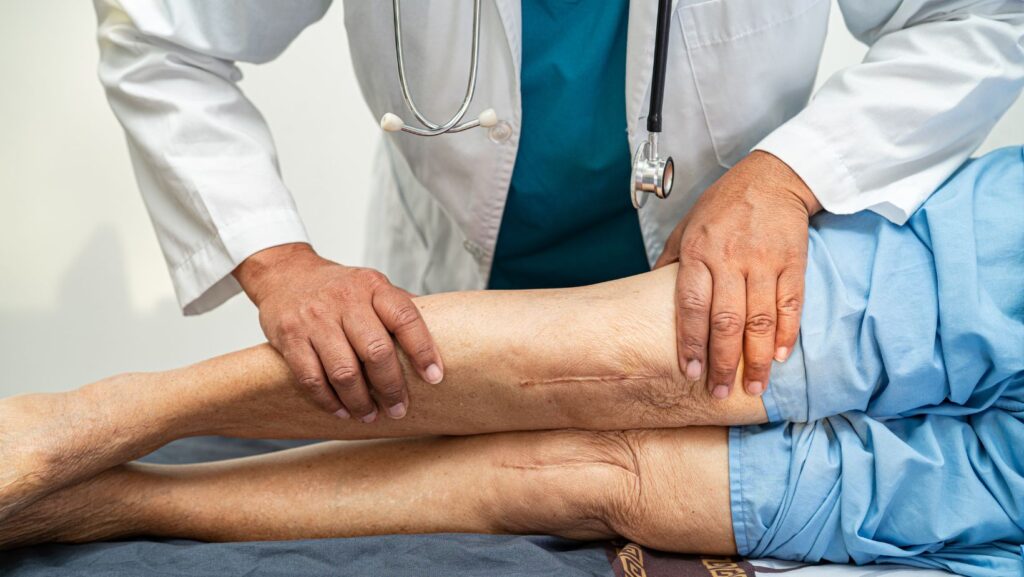Total knee replacement surgery helps people with severe knee problems. It can fix pain and stiffness that make daily tasks hard. Many people need this surgery when they have trouble walking, climbing stairs, or getting up from chairs.
The surgery replaces damaged knee parts with new artificial ones. This can greatly improve a person’s quality of life. It allows them to move more easily and with less pain.
New methods make recovery faster and easier. Doctors use special care plans and less invasive surgery techniques. These help patients heal quicker and feel better sooner after their operation.
Understanding Total Knee Replacement
Total knee replacement is a major surgery that can help people with severe knee problems. It involves replacing damaged parts of the knee joint with artificial components.
Indications for Surgery

Doctors may recommend knee replacement when other treatments don’t work. Common reasons include:
- Severe arthritis pain • Difficulty walking or climbing stairs • Knee stiffness or swelling that doesn’t improve • Bowing of the leg
The surgery is often done for people over 50 with arthritis. But younger patients may need it too if they have bad knee damage. Doctors look at X-rays, physical exams, and how much pain affects daily life before suggesting surgery.
Benefits of Knee Arthroplasty
Knee replacement can greatly improve quality of life. Key benefits are:
- Less pain • Better knee function • Easier walking and moving • More independence with daily tasks
Most patients see big improvements in pain and mobility. Many can return to activities they enjoyed before knee problems started. The artificial joint usually lasts 15-20 years or more.
Risks and Complications
While most knee replacements go well, there are some risks:
- Infection (1-2% of cases) • Blood clots • Continued pain or stiffness • Implant problems
Rare but serious issues can include nerve damage or implant failure. Revision surgery may be needed if problems occur.
Patients can help lower risks by:
- Following doctor’s orders • Doing physical therapy exercises • Maintaining a healthy weight • Not smoking
The surgery team takes many steps to prevent complications during and after the procedure.
The Road to Recovery
Recovery after total knee replacement surgery involves rehabilitation, advanced techniques, and personalized care plans. These approaches help patients regain mobility and strength while managing pain effectively.
Postoperative Rehabilitation
Physical therapy is key to knee replacement recovery. Patients start simple exercises soon after surgery to improve knee movement and strength. A therapist guides patients through low-impact activities like walking and stationary cycling.
As recovery progresses, exercises become more challenging. Patients may use weights or resistance bands to build muscle. Swimming and water aerobics are often recommended for their low-impact nature.
Proper pain management is crucial during rehabilitation. Doctors may prescribe medication to help patients stay comfortable while exercising. Ice and elevation can also reduce swelling and discomfort.
Advanced Surgical Techniques
Modern knee replacements use minimally invasive methods. These techniques involve smaller incisions and cause less tissue damage. This leads to less pain and faster healing for many patients. If you’re experiencing knee pain and are considering treatment options, the Centers For Knee Pain can provide personalized care and expert advice on advanced treatments.
Computer-assisted surgery helps doctors place implants more precisely. Robotic arms can guide surgical tools, improving accuracy. These methods often result in better knee function after recovery.
Some surgeons use patient-specific implants. These are custom-made to fit a person’s unique knee shape. This can lead to a more natural feel and potentially longer-lasting results.
Developing an ERAS Approach

Enhanced Recovery After Surgery (ERAS) plans aim to speed up healing. These programs start before surgery and continue through recovery. Patients learn what to expect and how to prepare their bodies.
ERAS often includes early mobilization after surgery. Patients may stand or walk the same day as their operation. This helps prevent blood clots and maintain muscle strength.
Pain control is tailored to each patient’s needs. Doctors may use nerve blocks or long-acting local anesthetics. This can reduce the need for strong pain medicines that might slow recovery.
Nutrition plays a big role in ERAS. Patients may drink clear fluids up until a few hours before surgery. After surgery, they’re encouraged to eat regular food as soon as possible.
